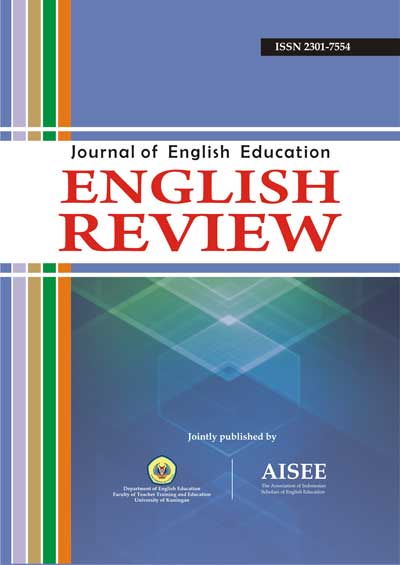IMPROVING STUDENTS’ COMPETENCE IN WRITING DESCRIPTIVE TEXTS THROUGH “FRESH†TECHNIQUE
Abstract
Abstract: This research was aimed to know whether “FRESH†technique can improve students’ competence in writing descriptive texts. This research was conducted in one of the junior high schools in Banyumas in academic year 2012/2013. The method of this research is Classroom Action Research (CAR). The research participants were the students of VIII E class consisting of 28 students. The treatment was carried out in two cycles of four actions, from November 9th, 2012 to December 1st, 2012. The quantitative data (tests) were evaluated by using Burhan Nurgiyantoro’s Writing Evaluation Criteria which consisted of evaluation in content, organization, vocabulary, language, and mechanics. Based on the data analysis, it could be described that the students’ competence in writing descriptive texts improved. It could be seen from the improvement of students’ score in pre-test and post test. The improvement of students’ score was 23.607%. This meant that “FRESH†technique improved the students’ competence in writing descriptive text in the eighth grade students of in academic year 2012/2013.
Keywords: descriptive text, FRESH Technique, Classroom Action Research, writing competence
References
Arikunto, S. (2010). Prosedur penelitian: Suatu pendekatan praktik. Jakarta: Rineka Cipta.
Brown, H. D. (2004). Language assessment: Principles and classroom practices. San Francisco State University.
Faisal. (2010). Penerapan “FRESH†untuk mengembangkan paragraf deskriptif bagi guru LBPP LIA Purwokerto. Purwokerto. Unpublished Research Report.
Harmer, J. (2003). The practice of English language teaching, third edition. England: Edinburg Gate.
--------------. (2006). How to teach writing. England: Longman.
Hernowo. (2003). Quantum writing. Bandung: Mizan Learning Center.
Hudson, L. S. A. (2011). Enhancing academic writing competence in Radiography Education. CPUT Theses and Dissertations. Accessed on May 21st 2012.
Kane, T. S. (2000). The Oxford essential guide to writing. New York: Berkley Books. Accessed on February, 20th 2013
Lyons, L. H. (1987). Study writing course in written English for academic and professional purpose. London: Cambridge University.
Martani, A. T. P. (2011). An effort to improve students’ writing ability using scaffolding strategy at the VIII Grade of SMP N 1 Patikraja Academic Year 2010/2011. Unpublished thesis, Muhammadiyah University of Purwokerto.
Murphy, R. (1994). English grammar in use. United Kingdom: Cambridge University Press.
Nurgiyantoro, B. (2001). Penelitian dalam pengajaran bahasa dan sastra. Yogyakarta: BPFE.
O’Malley, J M., & Valdez,L. (1996). Authentic assessment for English language learners. USA: Addison-Wesley Publishing Company, Inc.
Rozi, F. (2012). Descriptive text – language features. Accessed on June, 12th 2012 at https://peperonity.com/go/sites/mview/descriptive/14825324.
Suwandita, K. (2013) The effectiveness of FRESH technique to teach descriptive writing at the tenth grade students of MAN 1 Purwokerto in academic year 2012/2013. Unpublished thesis, Muhammadiyah University of Purwokerto.
Tarigan, H. G. (1994). Menulis sebagai suatu keterampilan berbahasa. Bandung: Angkasa.
Wardiman, A., Masduk B. J., and Djusma, M. S. (2008) English in focus 2. Jakarta: Pusat Perbukuan, Departemen Pendidikan Nasional.
Wishon, G. E., & Julia, M. B. (1980). Let’s write English, revised edition. New York: Litton Educational Publishing Inc.
All articles published in English Review: Journal of English Education (ERJEE) are licensed under the Creative Commons Attribution 4.0 International License (CC BY 4.0).
Copyright Ownership
Authors retain the copyright of their articles and grant ERJEE the right of first publication. The journal is granted a non-exclusive license to publish, reproduce, and distribute the article in any format, medium, or platform, provided that proper credit is given to the original authors.
License Terms – CC BY 4.0
Under the Creative Commons Attribution 4.0 International License, others are free to:
- Share — copy and redistribute the material in any medium or format
- Adapt — remix, transform, and build upon the material for any purpose, even commercially
As long as they:
- Provide appropriate credit to the original author(s) and source
- Provide a link to the license (https://creativecommons.org/licenses/by/4.0/)
- Indicate if any changes were made
There are no restrictions on the reuse, reproduction, or adaptation of published articles as long as attribution is properly given.
Author Warranties
By submitting a manuscript to ERJEE, authors confirm that:
- The work is original and does not infringe any existing copyright.
- The manuscript has not been previously published and is not under consideration elsewhere.
- All sources and references are appropriately acknowledged.
- Necessary permissions have been obtained for any copyrighted materials used.










